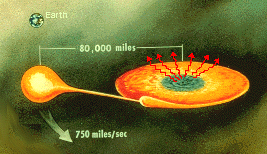Mass Exchange in X-ray Binary Stars
It was not clear from the early X-ray observations of the sky just exactly what was the origin of the amazingly bright sources that were being detected. In the early 1970s, data from the Uhuru satellite resulted in the association of several of these X-ray sources with mass exchange occurring between a normal star and a compact object (such as a neutron star or black hole) in a bound system. Theoreticians had long before shown that material falling onto such an object would be an efficient producer of X-rays.
Mass exchange in a binary system can occur by three modes:
1. Roche-lobe overflow of the primarily

For a low-mass X-ray binary (LMXRB, where a compact object is bound to a star whose mass is similar to or less than that of our Sun), the only way to achieve enough mass transfer to create large fluxes of X-rays is through Roche-lobe overflow. The Roche-lobe is the location between the two stars in a binary where the gravitational pull from one star is equal and opposite that of the other star. If the binary system is "close", i.e. the orbital radius is small, this point can occur near the surface of the normal star. Thus a "funnel point" is created for significant mass to flow out toward the compact star for accretion. In the case of Roche-lobe overflow, the angular momentum of the accreting material will tend to form a differentially rotating disk around the secondary. The material in this accretion disk is then slowly spiraled into the intense gravitational well of the compact object. It heats up to temperatures over 1,000,000 degrees and, therefore, shines brightly in X-rays.
2. Enhanced stellar wind from the primary
A number of X-ray binaries are known to consist of a massive primary emitting a stellar wind driven by the primary's radiation pressure, orbited by a neutron star or black hole. Such a system is called a HMXRB, or high-mass X-ray binary; the primary typically has a mass 10 times or more than that of our Sun. The compact object captures a fraction of the wind and converts the potential energy of the accreted plasma into X-rays. While qualitatively feasible, X-ray production by accretion from an undisturbed spherical wind can fall several orders of magnitude below the observed luminosity in the case of some binary systems (e.g., SMC X-1 and Cen X-3). However, simple modifications to the basic theory brought the observations closer to prediction. Such modifications include the effect of the X-ray emission on the velocity of the incoming wind and an angular dependence of the primary's mass loss.
3. Capture of circumstellar material from a Be star primary
In a Be star/neutron star binary, the behavior of the Be star controls the X-ray characteristics of the system. A Be star is a B star that rotates so rapidly that an instability results by which material streams out from the equatorial plane and an expanding atmosphere is formed. This introduces strong emission lines of hydrogen and neutral helium into the stellar spectrum. Furthermore, these stars are known to throw off large amounts of matter from their equatorial regions at apparently random intervals. The capture and accretion of this material by the secondary is known to be the source of many of the observed X-ray transients.
Last Modified: January 2011


